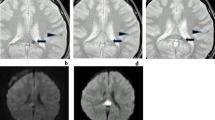Abstract
Intracerebral haemorrhage may be visible indefinitely on MRI, due to persistence of haemosiderin in macrophages around the lesion, but it is not clear whether all haemorrhages produce haemosiderin or, if not, what proportion cannot be identified as former haemorrhages on routine MRI. We performed routine MRI (spin-echo T2- and proton-density weighted images) in 116 survivors of moderate to severe head injury, 1–5 years after injury. We reviewed the images blindly and correlated them with CT in the acute stage, to determine how many haemorrhages from the acute stage were identifiable by virtue of haemosiderin deposition on late MRI. Of 106 haemorrhages in 78 patients on CT at the time of injury, 96 (90 %) were visible as haemosiderin on late MRI. Of the old haemorrhages without haemosiderin, seven of ten were in patients where another haemorrhage with haemosiderin was still visible elsewhere in the brain. No patient or haemorrhage features explained the formation or absence of haemosiderin. Thus about 10 % of definite haematomas show no trace of haemosiderin on routine spin-echo MRI. Radiologists should be alerted to supplement routine spin-echo with gradient-echo sequences if there is a reason to suspect, or specifically exclude, prior haemorrhage.
Similar content being viewed by others
Author information
Authors and Affiliations
Additional information
Received: 20 April 1999/Accepted: 1 July 1999
Rights and permissions
About this article
Cite this article
Wardlaw, J., Statham, P. How often is haemosiderin not visible on routine MRI following traumatic intracerebral haemorrhage?. Neuroradiology 42, 81–84 (2000). https://doi.org/10.1007/s002340050019
Issue Date:
DOI: https://doi.org/10.1007/s002340050019




